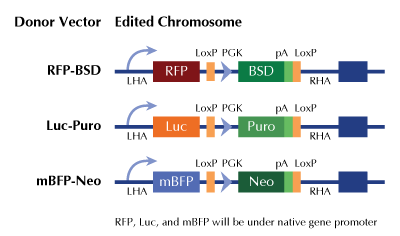TMPRSS2 Human Gene Knockout Kit (CRISPR)
CAT#: KN208677BN
TMPRSS2 - human gene knockout kit via CRISPR, HDR mediated
Functional Cassette: GFP-puro Luciferase-Puro RFP-BSD
HDR-mediated knockout kit validation
USD 1,657.00
4 Weeks*
Specifications
| Product Data | |
| Format | 2 gRNA vectors, 1 mBFP-Neo donor, 1 scramble control |
| Donor DNA | mBFP-Neo |
| Symbol | TMPRSS2 |
| Locus ID | 7113 |
| Components |
KN208677G1, TMPRSS2 gRNA vector 1 in pCas-Guide CRISPR vector KN208677G2, TMPRSS2 gRNA vector 2 in pCas-Guide CRISPR vector KN208677BND, donor DNA containing left and right homologous arms and mBFP-Neo functional cassette. GE100003, scramble sequence in pCas-Guide vector |
| Disclaimer | These products are manufactured and supplied by OriGene under license from ERS. The kit is designed based on the best knowledge of CRISPR technology. The system has been functionally validated for knocking-in the cassette downstream the native promoter. The efficiency of the knock-out varies due to the nature of the biology and the complexity of the experimental process. |
| Reference Data | |
| RefSeq | NM_001135099, NM_005656 |
| UniProt ID | O15393 |
| Synonyms | PP9284; PRSS10 |
| Summary | This gene encodes a protein that belongs to the serine protease family. The encoded protein contains a type II transmembrane domain, a receptor class A domain, a scavenger receptor cysteine-rich domain and a protease domain. Serine proteases are known to be involved in many physiological and pathological processes. This gene was demonstrated to be up-regulated by androgenic hormones in prostate cancer cells and down-regulated in androgen-independent prostate cancer tissue. The protease domain of this protein is thought to be cleaved and secreted into cell media after autocleavage. This protein also facilitates entry of viruses into host cells by proteolytically cleaving and activating viral envelope glycoproteins. Viruses found to use this protein for cell entry include Influenza virus and the human coronaviruses HCoV-229E, MERS-CoV, SARS-CoV and SARS-CoV-2 (COVID-19 virus). Alternatively spliced transcript variants encoding different isoforms have been found for this gene. [provided by RefSeq, Apr 2020] |
Documents
| Product Manuals |
| FAQs |
| SDS |
Resources
Other Versions
| SKU | Description | Size | Price |
|---|---|---|---|
| KN208677 | TMPRSS2 - human gene knockout kit via CRISPR, HDR mediated |
USD 1,657.00 |
|
| KN208677LP | TMPRSS2 - human gene knockout kit via CRISPR, HDR mediated |
USD 1,657.00 |
|
| KN208677RB | TMPRSS2 - human gene knockout kit via CRISPR, HDR mediated |
USD 1,657.00 |
|
| KN408677 | TMPRSS2 - KN2.0, Human gene knockout kit via CRISPR, non-homology mediated. |
USD 1,657.00 |
|
| GA104914 | TMPRSS2 CRISPRa kit - CRISPR gene activation of human transmembrane serine protease 2 |
USD 1,657.00 |
{0} Product Review(s)
Be the first one to submit a review






























































































































































































































































 Germany
Germany
 Japan
Japan
 United Kingdom
United Kingdom
 China
China
